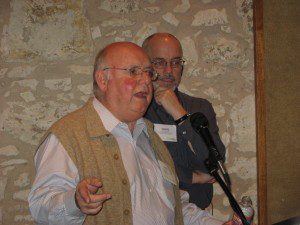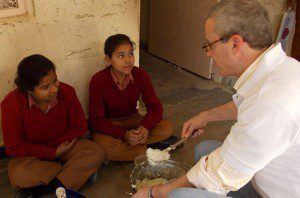It was August 25, 2005. A group of food bank leaders from the US, Canada and Mexico met to determine how to address the growing need for food banks around the world. They decided to establish a new, international organization to create and support food banks around the world.
They came up with a name – The Global FoodBanking Network (GFN) – and went right to work forming an organization that, last year, helped a thriving network of 752 food banks in 34 countries feed more than 6.5 million people.
Chris Rebstock, GFN’s Senior Vice President was there when GFN was being created by the late Bob Forney and Bill Rudnick. They were all present at that August meeting ten years ago. Chris was Vice President of Programs at America’s Second Harvest (now Feeding America) at the time. He remembers the events that lead to this important day …
By Chris Rebstock, GFN Interim President and CEO and Senior Vice President – Network Development
While you likely know about the Three Musketeers, you may not know what they have to do with GFN. That connection came from my friend and mentor, the late Bob Forney. Throughout the first decade of this century, Bob was the inspirational leader in the promotion of food banking, both in the US and around the world. Bob often reminded us that in order for food banks to proliferate, the network must adhere to the motto of the Three Musketeers: “All for one and one for all.”
Bob believed that sharing experiences – successes as well as failures – is the very foundation of a dynamic and sustainable food bank network. So, if GFN helps a food bank in one country, that country has a moral obligation to share what they learned from us. If we all share, we will be able to spread food banking around the world and help millions of people in need.

It was the late 1990s and I was leading the Network Services team at America’s Second Harvest (now Feeding America), supporting food banks throughout the US.
Food banking was a proven, mature, and successful concept in North America. Food banks had spread from the US to Canada and Mexico, where national networks coordinated activities in those countries. John Van Hengel, the founder/father of US food banking, started a consulting organization to help spread the food banking internationally.
The buzz was building and, at America’s Second Harvest, we were at the center of it. Requests from people who wanted to start food banks in other countries had started coming in during the 1980s, and the frequency and seriousness of inquiries was rapidly increasing. While our focus was strictly domestic, we shared what resources we had.
One day late in 2000, a priest from Argentina unexpectedly dropped by our office and asked for advice on starting a food bank in Buenos Aires. We talked a long time and I gave him a box full of materials to take home. His parting request: “When we build our food bank will you certify us so global companies will know that we meet the strict operating standards of America’s Second Harvest? This will help us to establish credibility and motivate their support.”
America’s Second Harvest, of course, only certified US food banks … but his logic was sound, so I agreed. Frankly, I did not expect the initiative to be successful. We continued, however, to maintain contact and were able to provide advice to help them start the food bank. About a year later, they said they were ready for a certification visit.
By now, Bob Forney was our CEO. Bill Rudnick, at this point a tireless hunger fighter in the US who had proven experience in governance at the local food bank level and the national network level, served on the Board of Directors.
With Bob’s blessing, and as promised a year earlier, I went to Argentina. The local planning team and the food bank staff had done an amazing job, in part thanks to our remote assistance, and the food bank met all requirements for certification. In 2004 they asked us to come again because they had started seven more food banks and they wanted our help to start a national food bank network. So I returned, for two weeks this time. During the trip, I visited several additional food banks to offer advice on operations and administration, and to learn more about the Argentine context of food banking. Staff and Board leadership of every food bank came together for a three-day meeting to agree on the establishment, role, and empowerment of a national organization to coordinate and support the expansion of food banking throughout the country.

About the same time that we stepped foot in Argentina, we began discussions with food bank leaders in Canada and Mexico about creating a North American regional food bank network. When we compared notes we learned that the food bank networks in Canada and Mexico were receiving an increasing number of international calls for assistance also. So we broadened our focus and went to work evaluating the best way to promote and support the spread of food banking around the world.
In the summer of 2015, we gathered in Chicago at Piper Rudnick (now DLA Piper LLP) to evaluate the best way to promote and support the spread of food banking around the world. We explored the idea of creating a global network of food banks.
It was on this day that GFN moved from a concept to a concrete vision. The group met in Mexico and Bill Rudnick chaired a meeting to make a final decision about whether or not to create an organization to spread food banking around the world. The decision was unanimous. We created a name — The Global FoodBanking Network (GFN) — and got to work on a business plan.
Bob was scheduled to retire from his CEO position at America’s Second Harvest in mid-2006. But he had clearly been bitten by the food bank bug. So when we decided to create GFN, he jumped at the chance to lead.
I had been involved with US food banking for my entire career … and I loved my work. But, my experience in Argentina, and subsequent work that Bob and I had done with a team in Israel, whetted my appetite for international work. So in early 2006, when Bob asked me to join him at GFN, I agreed – and Bob and I became the first employees.
On July 3, 2006, GFN officially opened for business. Today, GFN works in 34 countries and the GFN Network is comprised of more than 750 food banks. GFN maintains strong collaborative relationships with Feeding America, The European Federation of Food Banks (FEBA) and the Food Banking Regional Network (focused on food bank development in the Middle East and parts of Africa and South Asia). GFN continues to grow and thrive by helping social entrepreneurs create food banks where they do not exist and strengthening food banks that are already in operation.
Our work, our growth and our success have helped put food banking on the global map. As the network has grown, businesses are able to engage across a broader range and on a much deeper level. Today food banking is in the first line of sight when a global company moves into a market and they will call GFN to see how they can help. That’s good for everybody.
I am continually inspired by the many people around the world who collaborate to support food banking. I work with a strong team of professionals at our headquarters in Chicago. We are very fortunate that Bill Rudnick is still closely involved as a Board member, friend, wise counselor, and supporter of our organization. Of course, the legacy of Bob Forney (who passed away in 2010) lives on through our work.
I hope you will continue to stay connected with GFN and learn more about our founding year and our goals for the future.
In the upcoming editions of eNews, we’ll remember GFN’s other co-founders – Bob Forney, GFN’s first President & CEO, and Bill Rudnick, GFN’s first Chairman and current Board Member. Stay tuned!
